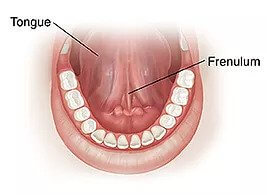TONGUE TIE IN CHILDREN
Pediatric Tongue Tie Specialist
Speech defects
in children

TONGUE TIE IN CHILDREN (LINGUAL FRENULUM)

PEDIATRIC LIP TIE (LABIAL FRENULUM)

CAUSES OF TONGUE TIE IN CHILDREN
SYMPTOMS OF A TONGUE TIE IN CHILDREN
- Bruised (or) bleeding nipple
- Infected nipples/breast/mastitis
- Clicking sounds while feeding
- Short sleep episodes
- Food in faeces
- Constipation
- Delayed speech
- Difficulty in brushing upper front teeth
- Gags easily
- Speech defects in children
- Forward neck and shoulder posture
- Sluggish eater / Picky eater / Slow eater
- Frequent cold, cough & allergies
- Digestive problems – refluxes, colic
- Grinding teeth at night
- Restlessness & lack of attention
- Day time sleepiness / Hyperactivity
- History of difficulty in breastfeeding
DIAGNOSIS OF TONGUE TIE IN CHILDREN
TONGUE TIE TREATMENT IN CHILDREN
- The child's medical history
- Clinical examination
- The severity of the condition
After a thorough history taking and clinical examination, depending on the severity of the condition the treatment is advised. In our practice we use the Functional Frenuloplasty procedure to release tongue ties for toddlers, children and adults. This unique and functional approach to tongue ties was established by globally renowned ENT & sleep surgeon Dr. Soroush Zaghi of Breathe Institute, Los Angeles. Dr. Ankita Shah has trained for this approach under Dr. Zaghi and is India’s only Ambassador of The Breathe Institute.

Dr. Shah is the Only
Indian Ambassador of
The Breathe Institute
Procedure by Dr. Soroush Zaghi
Frequently Asked Questions
You should see a tongue tie specialist for tongue ties in children. Dr. Ankita Shah is a pediatric tongue tie specialist, providing tongue tie diagnosis using evidence-based, comprehensive functional assessment. She also has a team of renowned specialists addressing various tongue tie issues.
There are certain tongue tie symptoms that you can look out for in your child, such as picky eating, speech issues, hyperactivity, etc. However, tongue tie may be misdiagnosed in many cases. Hence, it is advised to see a tongue tie specialist. Dr. Ankita Shah, is a renowned tongue tie specialist with years of experience in diagnosing tongue tie.
Dr. Ankita Shah is a renowned pediatric dentist for tongue tie in India. She is well known for providing the best tongue tie treatments in infants, children and adults. Her pediatric tongue tie surgery is painless, and when combined with virtual myofunctional therapy, it gives life-altering relief.
No, a pediatric tongue tie cannot go away on its own. If left untreated, it can manifest into various health issues such as snoring, posture, jaw growth and speech problems. A pediatric tongue tie surgery is the best option to correct it.
Yes, with the specialized procedures like Oral Myofunctional Therapy and Functional Frenuloplasty procedure used by Dr. Ankita during pediatric tongue tie surgery offer relief from various tongue tie related problems. When combined with her treatment, speech therapy and post-procedure exercises, you will see improvement in your child’s speech problem.
OUR ADVANCED & GLOBALLY RENOWNED TONGUE TIE PROCEDURES:
Blogs

What Happens If I Don’t Treat My Child’s Tongue-Tie?
As a parent, your child’s health and development are your top priorities. But what if something..

How Do Babies Feed After Tongue-Tie Surgery? A Complete Guide for Parents
When your baby struggles to breastfeed or bottle-feed, it can be very frustrating and emotional

How Tongue Tie Impacts Nutrition and Feeding in Children?
Have you ever noticed your baby struggling to latch while breastfeeding? Or maybe your child..

How Laser Frenectomy Helps Improve Breastfeeding for Newborns?
Breastfeeding is a beautiful and essential bonding experience between a mother and her newborn.

Innovative Advances in Tongue Tie Treatment: What’s New?
A condition known as tongue-tie, or ankyloglossia, limits the range of motion of the tongue.

How Tongue Tie Affects Speech Development in Children and Adults?
Tongue tie, also called ankyloglossia, may seem like a technical word, many adults and parents should..

Tongue Tie Compensations: Fascial Restrictions, Tension And Pain
Fascia is a connective tissue more like a spider web that provides our body a continuous 3-dimensional

6 Steps Of Assessment: Do I Have A Tongue Tie?
The back of the tongue should be resting high up on the palate. This helps in keeping the airway wide open.

What Exactly Is A Tongue Tie? How Does It Affect Us?
#DidYouKnow the tongue has 8 muscles which can exert 500gms of force? We have almost always neglected

The Unexpected Reason Behind My Son’s Picky Eating
As much as I joke about how difficult it is to get my kids to eat, I’m not joking today. My oldest son













